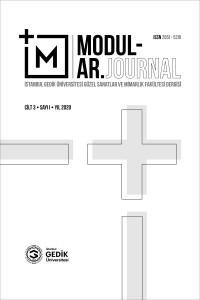Abstract
The article proposes an analysis of the role of American Board of Commissioners for Foreign Missions (ABCFM) during the late Ottoman and the early nationalist (Republican) Turkey and focusses especially on the ABCFM organization and the role of Protestant missionaries, which they succeeded in establishing autonomous schools, hospitals, clinics, orphanages, lodgings and ateliers not only in the capitals, but also in provinces.
The American Board began evangelism among Armenians, and the education and the social services became part of the Protestant movement in the Near East. Following efforts to Christianize the nations through evangelism, in the mid of 19th century, Merzifon (Marsovan) province was chosen due to its location in the middle of Anatolia and Merzifon Anatolia College was designed as an important ‘station’ in order to support the American missionary movements. Then, between the years 1886 and 1938, ABCFM built strong connections with Anatolia College in Merzifon to gain a very important strategic position.
In the context of the First World War, the function of the Anatolia College buildings has changed for different aims; the military used these buildings as the Artillery Regiment. After the war the ABCFM’s network broke down but its strong contribution to present education in Turkey is inevitable. The site as a heritage is still an active part of the city’s cultural life with some existing buildings of ABCFM supporting culture and education. For instance Merzifon Anatolia College Hospital is used by Merzifon High School for Science, Merzifon Anatolia College Library and Museum Building are used by Amasya University as Vocational School Administration Building. The other College buildings have been used by the Ministry of National Defense for many years. The North College, for instance, served as Noncommissioned Officer School during the First World War.
In this study, cultural sustainability of the Merzifon Anatolia College buildings each constructed with different aims and various stories has been investigated. As a method, the historical background of the site and the buildings has been revealed through archive documents and interviews have been held with historians. A detailed field search has been carried out to document the current status and usages of the buildings.
Protecting aura with the function of the building thus its authenticity is an opinion that is supported by many theorists but when the function is no longer valid, sustainability of aura is in danger. In this sense, the present usage of the Anatolia College buildings for educational purposes might be the indication that
the aura of the past is still culturally sustained.
Abstract
The article proposes an analysis of the role of American Board of Commissioners for Foreign Missions (ABCFM) during the late Ottoman and the early nationalist (Republican) Turkey and focusses especially on the ABCFM organization and the role of Protestant missionaries, which they succeeded in establishing autonomous schools, hospitals, clinics, orphanages, lodgings and ateliers not only in the capitals, but also in provinces.
The American Board began evangelism among Armenians, and the education and the social services became part of the Protestant movement in the Near East. Following efforts to Christianize the nations through evangelism, in the mid of 19th century, Merzifon (Marsovan) province was chosen due to its location in the middle of Anatolia and Merzifon Anatolia College was designed as an important ‘station’ in order to support the American missionary movements. Then, between the years 1886 and 1938, ABCFM built strong connections with Anatolia College in Merzifon to gain a very important strategic position.
In the context of the First World War, the function of the Anatolia College buildings has changed for different aims; the military used these buildings as the Artillery Regiment. After the war the ABCFM’s network broke down but its strong contribution to present education in Turkey is inevitable. The site as a heritage is still an active part of the city’s cultural life with some existing buildings of ABCFM supporting culture and education. For instance Merzifon Anatolia College Hospital is used by Merzifon High School for Science, Merzifon Anatolia College Library and Museum Building are used by Amasya University as Vocational School Administration Building. The other College buildings have been used by the Ministry of National Defense for many years. The North College, for instance, served as Noncommissioned Officer School during the First World War.
In this study, cultural sustainability of the Merzifon Anatolia College buildings each constructed with different aims and various stories has been investigated. As a method, the historical background of the site and the buildings has been revealed through archive documents and interviews have been held with historians. A detailed field search has been carried out to document the current status and usages of the buildings.
Protecting aura with the function of the building thus its authenticity is an opinion that is supported by many theorists but when the function is no longer valid, sustainability of aura is in danger. In this sense, the present usage of the Anatolia College buildings for educational purposes might be the indication that
the aura of the past is still culturally sustained.
Details
| Primary Language | English |
|---|---|
| Subjects | Architecture |
| Journal Section | Erratum |
| Authors | |
| Publication Date | June 29, 2020 |
| Submission Date | June 28, 2020 |
| Published in Issue | Year 2020 Volume: 3 Issue: 1 |

